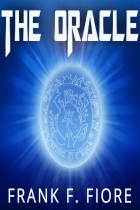Frank Fiore is a bestselling author with more than 50,000 copies of his non-fiction books in print. He has now turned his talents to writing fiction. His first novel is the five star rated cyber-thriller titled Cyberkill. This was followed up with the five star rated three book series titled the Chronicles of Jeremy Nash. His latest work is a book of speculative and Sci-Fi short stories titled The Oracle.
Please tell everyone a little about yourself, Frank.
 Frank: I’m from Brooklyn, New York. I wrote “To Christopher” under the guise of a book to my young son that leads the reader through social commentary, personal experience and entertaining stories, which take the reader on a thoughtful journey through the challenges and opportunities facing the next generation. My writing experience also includes guest columns on social commentary and future trends published in the Arizona Republic and the Tribune papers in the metro Phoenix area. Through my writings, I’ve shown an ability to explain, in a simplified manner, complex issues and trends.
Frank: I’m from Brooklyn, New York. I wrote “To Christopher” under the guise of a book to my young son that leads the reader through social commentary, personal experience and entertaining stories, which take the reader on a thoughtful journey through the challenges and opportunities facing the next generation. My writing experience also includes guest columns on social commentary and future trends published in the Arizona Republic and the Tribune papers in the metro Phoenix area. Through my writings, I’ve shown an ability to explain, in a simplified manner, complex issues and trends.
When did the writing bug bite, and in what genre(s)?
Frank: In high school. I started a novel but never finished it. Then one summer while in college I did finish a complete Sci-Fi novel. I still have it. It was derivative and not very good.
When you started writing, what goals did you want to accomplish? Is there a message you want readers to grasp?
Frank: Number one – I want to be a noted author with a following. Not get rich, necessarily – which would be nice – but to know that what I have written has entertained my readers and perhaps informed them at the same time.
Briefly tell us about your latest book. Is it part of a series or stand-alone?
 Frank: It’s called The Oracle and consists of a series of short stories tied together by means of a background story – a story within a story (similar to Ray Bradbury’s Illustrated Man). And like the Jeffrey Archer and Twilight Zone stories, the Oracle short stories are written with surprise endings.
Frank: It’s called The Oracle and consists of a series of short stories tied together by means of a background story – a story within a story (similar to Ray Bradbury’s Illustrated Man). And like the Jeffrey Archer and Twilight Zone stories, the Oracle short stories are written with surprise endings.
The background story begins with a young musician on his way to Phoenix from Los Angles for a concert. He is given a car by his manager and shortly after entering Arizona it breaks down. Out in the middle of nowhere he decides to hitch a ride to the nearest town for help. While waiting for a ride, the weather turns inclement and he seeks refuge at a ranch house inhabited by an old and lonely couple. They invite him in and persuade him to stay for dinner.
After eating, they retire to the living room. After a while, the old woman offers to show their guest some of their three dimensional slides on their old-time stereoscope.
Being polite, the young man decides to endure the request. His hosts carefully remove a set of slides from a shiny metallic box from under the coffee table and place the first one in the stereoscope’s viewer. They instruct the young man to hold the stereoscope up to the living room lamp and focus it towards the viewer.When the viewer is focused and the light hits the slide, something amazing happens.
The still 3D image begins to move!
The first image he sees tells a tale that happens to be one of the short stories in the series. At the end of the first story, the young man turns to question his hosts on this wonderfully strange device. The couple just smile and offer him another slide. He asks again what the device is and where did it come from. The couple respond that the device is an ordinary stereoscope of the early 1900s that they purchased from a Sears catalog many years ago.
But the slides – ah yes, the slides. That’s another matter indeed.
What’s the hook for the book?
Frank: The main overall story and the all the short stories end in a twist – like the old Twilight Zone episodes. Some stories are meant to shock while others are whimsical. Either way, the endings are not predictable.
Do you have mental list or a computer file or a spiral notebook with the ideas for or outlines of stories that you have not written but intend to one day?
Frank: Many years ago, I started collecting ideas for my novels. I created file folders for each proposed story I would write. As I found any and all material that fit the story line, I would drop it into the assigned folder. This would include websites, books, news items, magazine articles, videos, etc. etc. This process has worked well for me in helping develop my stories.
How many stories do you currently have swirling around in your head?
Frank: I’ve completed five novels and currently doing research on a sixth novel. I have at least three more in the hopper.
Which is more important to your story, character or plot?
Frank: Plot. Plot. Plot. Without plot characters have nothing to do. Plot first then develop characters to drive the plot. And in the process, SHOW don’t TELL.
Who gave you the best writing advice you ever received and what was it?
Frank: A fellow popular author colleague of mine. Write, write and write. Create a back list of books. If one takes off, readers will flock to your other books. The more books you have in the marketplace the better return on your writing time when your first book becomes popular. Then Tom Clancy – yeah, that Tom Clancy – told me to don’t suffer over a book. Complete and go on to the next one.
How does your environment/upbringing color your writing?
Frank: I’m from Brooklyn, New York. A Brooklyn boy gets right to the point and in a way that communicates quickly and efficiently. You would know this if you ever spend time around New Yorkers. So that’s how I write. Conversationally without long boring narratives. If you want a quick entertaining read, then the The Oracle fits that bill.
Share the best review (or a portion) that you’ve ever had.
Frank: This is for the Chronicles of Jeremy Nash.
“I read Frank’s Jeremy Nash trilogy on the beach in Mexico over Christmas vacation. It was perfect. The characters were believable, the plot kept you guessing, the twists were surprising, and the action kept you turning the pages. All the books were a terrific read, written in a style that just keeps your eye moving and your imagination seeing what’s going on. Now I’m waiting for Nash’s next adventure.”
What are your current projects?
Frank: I’ve just finished my fifth novel. It’s called Murran. I expect this to be my breakthrough novel because it is steeped in politically incorrect controversy. It is getting very good reviews from my beta readers.
Murran is the story of a young African-American boy named Trey coming of age in the 1980s, and his rite of passage to adulthood. Trey is a member of a ‘crew’ in Brooklyn and is enticed into helping a violent drug gang. He is eventually framed for murder and flees with his high school teacher to his Maasai village in Kenya. There, Trey learns what a true Black African and African culture is, goes through the Maasai warrior’s rite of passage, becomes a young shaman, and returns to America to confront the gang leader that framed him.
Where can people learn more about your books?
Frank: Check out my author website at www.frankfiore.com and my blog at http://frankfiore.wordpress.com/
Thank you for joining us today, Frank.
Frank: Thanks for the opportunity.





 Larry: The older you get, the harder it is to be brief, to condense the lifetime journey into a paragraph or two in a biographical sketch. In your twenties, you pad the resume; by your forties, the thing stands on its own; by the time you are looking back at your sixties, radical compression and redaction are in order. What’s important, what irrelevant? What’s of interest? What is a boring distraction? I tell my students at the university where I teach that I am not a real professor but that I am a real industrial designer. Both parts are true — in part. What they reveal is a complexity hidden behind brevity. I have been a pioneer in software engineering, in family therapy, and in interaction design. I divide my time between Europe and the US. I am deeply entrenched in academia and in industry and fully belong in neither. I am a novelist. I write under a pen name, but my official identity is no secret. I do most of my writing evenings and weekends in my apartment near the University of Madeira. My loving wife and kids put up with my long absences. I love to cook. I am a composer and would write more music if I were not so busy writing novels.
Larry: The older you get, the harder it is to be brief, to condense the lifetime journey into a paragraph or two in a biographical sketch. In your twenties, you pad the resume; by your forties, the thing stands on its own; by the time you are looking back at your sixties, radical compression and redaction are in order. What’s important, what irrelevant? What’s of interest? What is a boring distraction? I tell my students at the university where I teach that I am not a real professor but that I am a real industrial designer. Both parts are true — in part. What they reveal is a complexity hidden behind brevity. I have been a pioneer in software engineering, in family therapy, and in interaction design. I divide my time between Europe and the US. I am deeply entrenched in academia and in industry and fully belong in neither. I am a novelist. I write under a pen name, but my official identity is no secret. I do most of my writing evenings and weekends in my apartment near the University of Madeira. My loving wife and kids put up with my long absences. I love to cook. I am a composer and would write more music if I were not so busy writing novels. Larry: My most recent novel is Chipset, which is both part of The Homeland Connection series and can be read on its own. Readers who missed the first three novels — Bashert, The Dome, and Web Game — will not be lost, but those who go back and catch up will be doubly rewarded.
Larry: My most recent novel is Chipset, which is both part of The Homeland Connection series and can be read on its own. Readers who missed the first three novels — Bashert, The Dome, and Web Game — will not be lost, but those who go back and catch up will be doubly rewarded.




















 Stumble It!
Stumble It!

